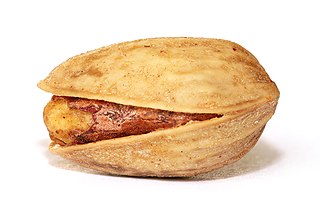
The pistachio, a member of the cashew family, is a small tree originating in Persia. The tree produces seeds that are widely consumed as food. The word can be countable or uncountable, meaning its plural is with or without an 's'.

Fruit tree propagation is usually carried out vegetatively (non-sexually) by grafting or budding a desired variety onto a suitable rootstock.

Fruit tree pruning is the cutting and removing of selected parts of a fruit tree. It spans a number of horticultural techniques. Pruning often means cutting branches back, sometimes removing smaller limbs entirely. It may also mean removal of young shoots, buds, and leaves.
Boron deficiency is a common deficiency of the micronutrient boron in plants. It is the most widespread micronutrient deficiency around the world and causes large losses in crop production and crop quality. Boron deficiency affects vegetative and reproductive growth of plants, resulting in inhibition of cell expansion, death of meristem, and reduced fertility.

Vegetative reproduction is a form of asexual reproduction occurring in plants in which a new plant grows from a fragment or cutting of the parent plant or specialized reproductive structures, which are sometimes called vegetative propagules.
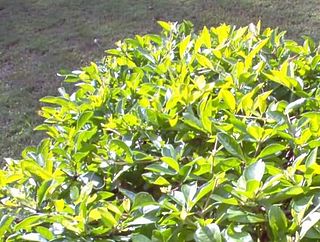
Pruning is a horticultural, arboricultural, and silvicultural practice involving the selective removal of certain parts of a plant, such as branches, buds, or roots.

In botany, a perennial plant or simply perennial is a plant that lives more than two years. The term is often used to differentiate a plant from shorter-lived annuals and biennials. The term is also widely used to distinguish plants with little or no woody growth from trees and shrubs, which are also technically perennials. Notably, it is estimated that 94% of plant species fall under the category of perennials, underscoring the prevalence of plants with lifespans exceeding two years in the botanical world.
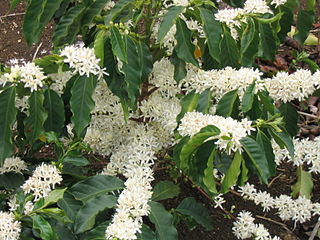
Coffea arabica, also known as the Arabica coffee, is a species of flowering plant in the coffee and madder family Rubiaceae. It is believed to be the first species of coffee to have been cultivated and is the dominant cultivar, representing about 60% of global production. Coffee produced from the less acidic, more bitter, and more highly caffeinated robusta bean makes up most of the remaining coffee production. The natural populations of Coffea arabica are restricted to the forests of South Ethiopia and Yemen.

The waratah (Telopea) is an Australian-endemic genus of five species of large shrubs or small trees, native to the southeastern parts of Australia. The best-known species in this genus is Telopea speciosissima, which has bright red flowers and is the New South Wales (NSW) state emblem. The waratah is a member of the family Proteaceae, flowering plants distributed in the Southern Hemisphere. The key diagnostic feature of Proteaceae is the inflorescence, which is often very large, brightly coloured and showy, consisting of many small flowers densely packed into a compact head or spike. Species of waratah boast such inflorescences ranging from 6–15 cm in diameter with a basal ring of coloured bracts. The leaves are spirally arranged, 10–20 cm long and 2–3 cm broad with entire or serrated margins. The name waratah comes from the Eora Aboriginal people, the pre-European inhabitants of the Sydney area.

The tamarillo is a small tree or shrub in the flowering plant family Solanaceae. It is best known as the species that bears the tamarillo, an egg-shaped edible fruit. It is also known as the tree tomato, tomate de árbol, tomate andino, tomate serrano, blood fruit, poor man's tomatoe, tomate de yuca, tomate de españa, sachatomate, berenjena, chilto and tamamoro in South America, tyamtar, rambheda or rukh tamatar in Nepal, and terong Belanda in Indonesia. It is popular globally, especially in Peru, Colombia, New Zealand, Ecuador, Nepal, Rwanda, Burundi, Australia, Bhutan and the United States.

Ziziphus mauritiana, also known as Indian jujube, Indian plum, Chinese date, Chinese apple, ber and dunks is a tropical fruit tree species belonging to the family Rhamnaceae. It is often confused with the closely related Chinese jujube, but whereas Z. jujuba prefers temperate climates, Z. mauritiana is tropical to subtropical.

In agriculture, a living mulch is a cover crop interplanted or undersown with a main crop, and intended to serve the purposes of a mulch, such as weed suppression and regulation of soil temperature. Living mulches grow for a long time with the main crops, whereas cover crops are incorporated into the soil or killed with herbicides.

Malus sieversii is a wild apple native to the mountains of Central Asia in southern Kazakhstan. It has recently been shown to be the primary ancestor of most cultivars of the domesticated apple. It was first described as Pyrus sieversii due to its similarities with pears in 1833 by Carl Friedrich von Ledebour, a German naturalist who saw them growing in the Altai Mountains.

Worldwide more human beings gain their livelihood from agriculture than any other endeavor; the majority are self-employed subsistence farmers living in the tropics. While growing food for local consumption is the core of tropical agriculture, cash crops are also included in the definition.

Cytisus proliferus, tagasaste or tree lucerne, is a small spreading evergreen tree that grows 3–4 m (10–13 ft) high. It is a well known fertilizer tree. It is a member of the Fabaceae (pea) family and is indigenous to the dry volcanic slopes of the Canary Islands, but it is now grown in Australia, New Zealand and many other parts of the world as a fodder crop.
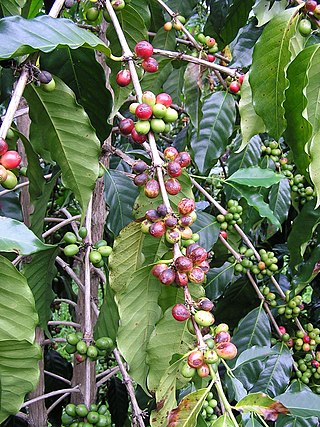
Mycosphaerella coffeicola is a sexually reproducing fungal plant pathogen. It is most commonly referred to as the asexual organism Cercospora coffeicola.

Carissa macrocarpa is a shrub native to tropical and southern Africa. It is commonly known as the Natal plum and, in South Africa, the large num-num. In Zulu, as well as in the Bantu tribes of Uganda, it is called Amathungulu or umThungulu oBomvu. In Afrikaans the fruit is called noem-noem.

Agriculture in Ethiopia is the foundation of the country's economy, accounting for half of gross domestic product (GDP), 83.9% of exports, and 80% of total employment.
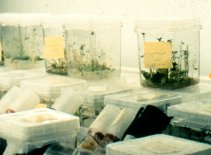
Plant tissue culture is a collection of techniques used to maintain or grow plant cells, tissues, or organs under sterile conditions on a nutrient culture medium of known composition. It is widely used to produce clones of a plant in a method known as micropropagation. Different techniques in plant tissue culture may offer certain advantages over traditional methods of propagation, including:
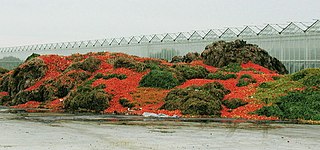
Post-harvest losses of vegetables and fruit occur at all points in the value chain from production in the field to the food being placed on a plate for consumption. Post-harvest activities include harvesting, handling, storage, processing, packaging, transportation and marketing.


















